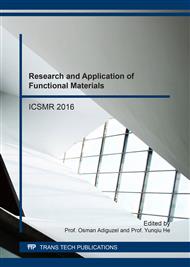p.69
p.74
p.78
p.83
p.89
p.93
p.101
p.105
p.110
Gold Nanoparticles Resistance Induced by Femtosecond Pulse Laser
Abstract:
We presented a new method to fabricate gold nanoparticles resistance using the deposition technique of Laser Induced Backward Transfer (LIBT). The femtosecond laser was focused on the surface of the gold film covered by a receiving substrate. The ablation was carried out by scanning the laser beam and the expanded plasma can be transferred to the receiving substrate, which forms nanoscale resistance composed of gold nanoparticles lines. Gold nanoparticles were characterized by optical microscope, scanning electron microscope (SEM) and atomic force microscope (AFM). Femtosecond laser fluence, scanning speed, and the space between the scanned lines can influence gold nanoresistance. The resistance of gold nanoparticles with different parameters varied from ~ 8 GΩ to ~ 40 GΩ, which was measured by the picoammeter. Linetype resistance with nanostructured particles can be widely used in the field of microelectronics and optoelectronic devices.
Info:
Periodical:
Pages:
89-92
Citation:
Online since:
July 2017
Authors:
Price:
Сopyright:
© 2017 Trans Tech Publications Ltd. All Rights Reserved
Share:
Citation:


